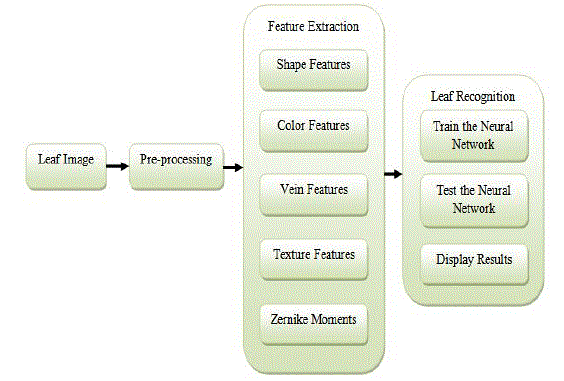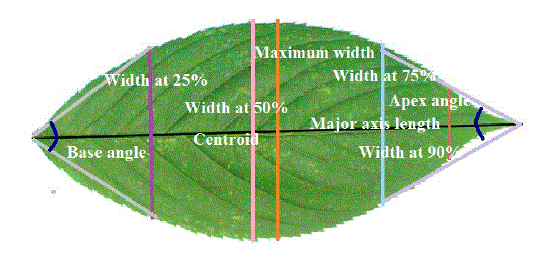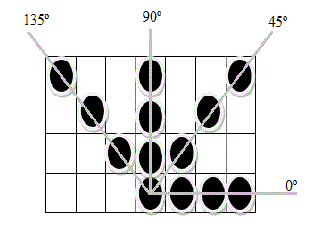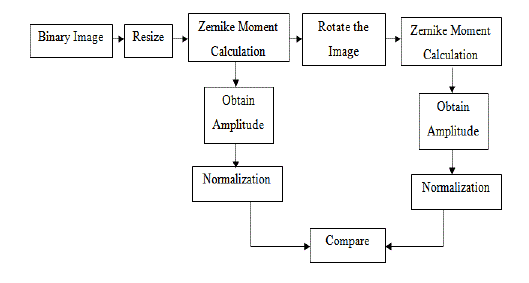Keywords
|
| Database, Neural Network, Species, Classify |
INTRODUCTION
|
| It is well known that plants play a crucial role in preserving earth’s ecology and environment by maintaining a healthy atmosphere and providing nourishment and shelter to manifold insect and animal species. Plants are also important for their medicinal properties, as alternative energy sources like bio-fuel and for meeting our various domestic requirements like timber, clothing, food and cosmetics. Leaves play a paramount role in identification of a plant due to its handiness nearly throughout the year, easiness to access, carry and process in computer. As the shape of plant leaves is one of the most important features for characterizing various plants visually, the study of leaf image retrieval schemes will be an important stage for developing a plant identification system . |
| Building a plant database for quick and efficient classification and recognition of various flora diversities is an important step towards their conservation and preservation. This is more important as many types of plants are now at the verge of extinction. In recent times computer vision methodologies and pattern recognition techniques have been successfully applied towards automated systems of plant categorizing. Centroid-contour distance curve and the eccentricity of the leaf objects are used as shape features [1]. But it did not produce accurate results. Some systems employ descriptions used by botanists [2]. But it is not easy to extract and transfer those features to a computer automatically. This paper tries to prevent human interference in feature extraction. 6 species of plants are identified [3]. No colour information was processed. They used aspect ratio, leaf dent, leaf vein, and invariant moment to identify plant. Other features that are incorporated in recognizing plants are extracted from vein of leaf (venation). Shape and venation are used for leaf image retrieval different species of leaves images and are used as database [4]. Colour moments represent colour features to characterize a colour image. It was used for image retrieval [5] and for skin texture recognition [6]. This present work includes colour, vein, and texture and vein feature extraction for improving recognition accuracies. Different leaf images are used as database for this project and it will be implemented using MATLAB. |
METHODOLOGY
|
| Block diagram of the proposed method is shown in Figure1. Pre-processing steps are performed on the leaf image. Different features of the leaf are obtained and these features are given as input to the neural network. Training and testing of the neural network is carried out and the result is obtained. |
| Pre-processing steps are performed on the leaf image. Different features of the leaf are obtained and these features are given as input to the neural network. Training and testing of the neural network is carried out and the result is obtained. |
| The features used in leaf recognition are described as follows: |
| A. Shape Features |
| There are several kinds of geometric features involved as shape features: |
| • Aspect ratio: The ratio of maximum width to major axis length. |
| • Width ratio: The ratio of width at half of major axis to maximum width. |
| • Apex angle: The angle at apex between leaf edges on width line at 3/4th of the major axis. |
| • Apex ratio: The ratio of the angle made at the apex by width at 9/10th of major axis to angle at 3/4th of major axis. |
| • Base angle: The angle at base between leaf edges on width line at 1/4th of the major axis. |
| • Moment ratio: The ratio between Y deviation and X deviation from the centroid of the leaf. It accounts for the mass distributed around the leaf, whether it is in longitudinal or lateral direction. If the value is greater than one, the leaf is longitudinal in nature; and vice versa. Whereas, a value equal to one classifies it as circular. |
| • Circularity: The ratio of 4*PI*Area of the leaf to the square of perimeter. |
| B. Color Features |
| Color features are essential for colour based image analysis. The information of colour distribution in an image can be captured by the low order moments. The first & second order moment has been proved to be efficient and effective in representing colour distribution of image. |
| • Moment 1: It is called Mean. It provides average Color value in the image. |
 (1) (1) |
| Where MN represents the total number of pixels in the image. |
| • Moment 2: It is called Standard Deviation. The standard deviation is the square root of the variance of the distribution. |
 (2) (2) |
| • Moment 3: It is called Skewness. It gives measure of the degree of asymmetry in the distribution. |
 (3) (3) |
| • Moment 4: It is called Kurtosis. It gives the measure of peakedness in the distribution. |
 (4) (4) |
| C. Vein Features |
| Vein features are features derived from vein of the leaf. There are four kinds of vein features, defined as follows: V1=A1/A, V2=A2/A, V3=A3/A, V4=A4/A WhereA1, A2, A3 and A4 are pixel number that constructs the vein and A is area of the leaf. The vein of the leaf is constructed by using morphological operation called opening. This operation is performed on the gray scale image with flat, disk-shaped structuring element of radius 1, 2, 3, 4 and subtracted remaining image by the margin. As a result, a structure like vein is obtained. Conversion from RGB image to gray scale image is done by using formula below: |
 (5) (5) |
| The algorithm involves following steps: |
| 1. Convert RGB image of the leaf to gray scale image : |
| • Gray scale leaf |
| 2. Obtain the threshold value of the gray scale image and convert the gray scale image to binary image with the above threshold value: |
| • Binary leaf |
| 3. Create four structure elements with disk shape and the radius 1,2,3 and 4 respectively: |
| • SE1- disk shape structure element, radius=1 |
| • SE2 - disk shape structure element, radius=2 |
| • SE3 - disk shape structure element, radius=3 |
| • SE4 - disk shape structure element, radius=4 |
| 4. Perform opening operation to both the structure elements: |
| • O1 - opening(SE1) |
| • O2 - opening(SE2) |
| • O3 - opening(SE3) |
| • O4 - opening(SE4) |
| 5. Subtract the grayscale images of the leaf by the result of the opening operation: |
| • R1 - subtract(Grayscale leaf, O1) |
| • R2 - subtract(Grayscale leaf, O2) |
| • R3 - subtract(Grayscale leaf, O3) |
| • R4 - subtract(Grayscale leaf, O4) |
| 6. Get the binary images of R1,R2,R3and R4 by using Otsu method: |
| • BW1 – Segmented by Otsu(O1) |
| • BW2 – Segmented by Otsu(O2) |
| • BW3 – Segmented by Otsu(O3) |
| • BW4 – Segmented by Otsu(O4) |
| 7. Calculate the total of pixels of BW1, BW2, BW3, and BW4: |
| • A1 - pixel number of BW1 |
| • A2 - pixel number of BW2 |
| • A3 - pixel number of BW3 |
| • A4 - pixel number of BW4 |
| 8. Calculate area of the leaf: |
| • A - area of(Binary leaf) |
| 9. Calculate the ratio of: |
| • V1 ← A1 / A |
| • V2 ← A2 / A |
| • V3 ← A3/ A |
| • V4 ← A4 / A |
| D. Texture Features |
| An image texture is a set of standard of measurements computed in image processing intended to enumerate the apparent texture of a leaf image. Leaf image texture gives information regarding the spatial arrangement of colour or intensities in a leaf image or selected region of a leaf image. Texture features are extracted from Gray Level Co-occurrence Matrices (GLCMs). GLCM is very useful to obtain valuable information about the relative position of the neighbouring pixels in an image [7]. The co-occurrence matrix GLCM (i,j) counts the co-occurrence of pixels with gray value i and j at given distance d. The direction of neighbouring pixels to represents the distance can be selected, for example 135o, 90o, 45o, or 0o, as illustrated in Figure 3. |
| E. Zernike Moments |
| As stated in the introduction, plants are generally recognized using the shape of the leaf. For this reason they cannot be appropriately described with the help of regular shape descriptors like circularity, linearity and so on. For this reason Zernike moments can be adopted. These moments have higher space feature vector and are normally of order N. If additional order of moments is considered, then we achieve better the recognition probability. Zernike moments are obtained from a transformed unit disk space that allows for the extraction of shape descriptors which are invariant to rotation, translation, and scale as well as skew and stretch, thus preserving more shape information for the feature extraction process. Figure 4 shows the computational block diagram. |
| If an image is presumed to be an object, its descriptors are recognized as its feature vectors. The Zernike polynomials defined over the interior of a unit circle x2+ y2= 1 are a set of complex and orthogonal polynomials. Zernike moment of order n and repetition m is defined as for a continuous image function f(x, y) are defined as, |
 (6) (6) |
| In the xy image plane, |
 (7) (7) |
| The real valued radial polynomial Rnm is defined as |
 (8) (8) |
| Using this equation Zernike moments from order 2 to 10 for extracting the necessary features can be computed. |
| F. Neural Network |
| The input layer accepts an input vector. The pattern layer processed the input vector by using weight vector came from training dataset. This layer compute the distances from the input layer to the training input. As a result, a vector that indicates how close the input is to a training input. Then, in the Summation layer, a vector contains probabilities is found by summing up the contributions for each class. This vector of probabilities is sent to the output layer. The last layer in PNN structure produces a classification decision, in which a class with maximum probabilities will be assigned by 1 and other classes will be assigned by 0[7].Figure 5 shows the general architecture of neural network. |
| For training the neural network, all features of training samples are inputted to the network. The next step, weights of the neural network that are obtained from training phase will be used to test the network. The results are compared to original classes to get performance of the system. This is done by matching an unknown leaf by the user. |
EXPERIMENTAL RESULTS
|
| Figure 6 a) shows the basic operations performed on leaf image and b) shows structure like vein obtained after processing with different structuring elements. |
| Figure 7 a) shows the result obtained using Zernike moments. It can be observed that even if there is change in phase, amplitude value did not alter. Figure 7 b) shows the Texture features obtained for different angles using GLCM. |
CONCLUSION
|
| Incorporating Zernike moments for feature descriptors is a feasible alternative for classifying structurally complex images. They offer exceptional invariance features and reveal enhanced performance than other moment based solutions. They can be computed in parallel and as the computational performance of computers increase; the time necessary for their calculation perhaps will not be a problem in the nearby future. GLCM gives better texture approximations and hence makes classification easier. |
| The database is prepared for the experimental use. The database contains various leaves with various shapes, colours and size. Experiment is carried out with the different leaves of different classes and tested. This paper investigated the use of a number of different colours, texture and shape features for leaf identification system. The features obtained from colour moments can be further used for indexing images based on colour. It can be further used for classification of leaves into respective diseases using various clustering algorithms. |
| |
Figures at a glance
|
 |
 |
 |
 |
| Figure 1 |
Figure 2 |
Figure 3 |
Figure 4 |
 |
 |
 |
| Figure 1 |
Figure 2 |
Figure 3 |
|
| |
References
|
- Wang, Z., Chi, Z., Feng, D., & Wang, Q. (2000). “Leaf Image Retrieval with Shape Features”. 4th International Conference on Advances in Visual Information Systems, pp. 477-487.
- H. Fu, Z. Chi, D. Feng, and J. Song(2004), “Machine learning techniques for ontology-based leaf classification,” in IEEE 2004 8th International Conference on Control, Automation, Robotics and Vision, Kunming, China.
- Wu, Q., Zhou, C., & Wang, C. (2006). “Feature Extraction and Automatic Recognition of Plant Leaf Using Artificial Neural Network”. Avances en Ciencias de la Computacion, pp. 5-12.
- Nam, Y., Hwang, E., & Kim, D. (2008). “A Similarity-based Leaf Image retrieval Scheme: Joining Shape and Venation Features”. Computer Vision and Image Understanding , 110, pp. 245-259.
- Choras, R. S. (2007). “Image Feature Extraction Techniques and Their Application for CBIR and Biometrics systems”. International Journal of Bilogy and Biomedical Engineering , 1(1), pp. 6-16.
- Dobrescu, R., Dobrescu, M., Mocanu, S., & Popescu, D. (2010). “Medical Images Classification for Skin canver Diagnosis Based on Combined Texture andFractal Analysis”. WISEAS Transactions on Biology and Biomedicine , 7(3), pp. 223-232.
- A.Kadir, L.E.Nugroha, A.Susanto, P.I.Santosa. (2011). “Neural Network Application on Foliage Plant Identification”. International Journal of Computer Applications ,Volume 29– No.9.
|